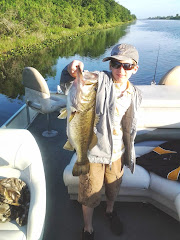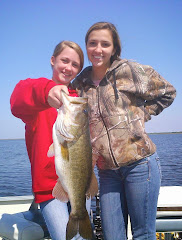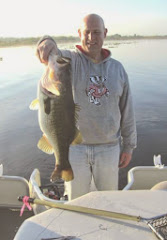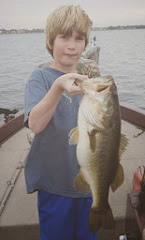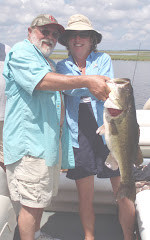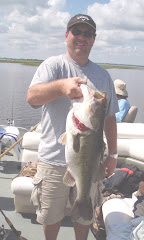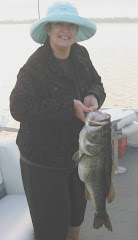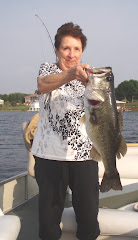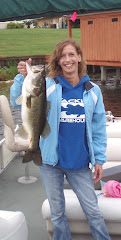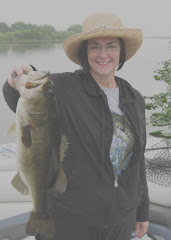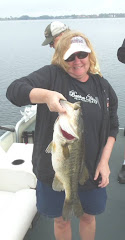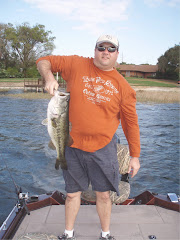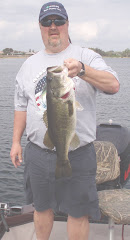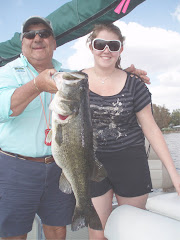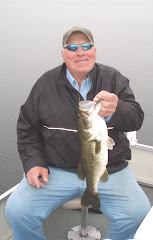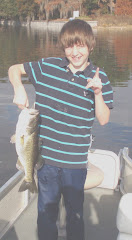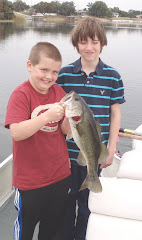Talk about "the one that got away....Whew!" I've heard just about every story about that, but this has got to be the best ever! Watch the video below.
Not only did he loose the fish ... but now he has to buy a new net, to boot! Thank goodness there are no Polar bears in Florida.
Tuesday, December 28, 2010
Monday, December 27, 2010
Don't Let The Trailer Get Too Deep!
He just bought a new boat and decided to take her for the maiden voyage.
This was his first boat and he wasn't quite sure of the exact Standard Operating Procedures for launching it off a ramp, but he figured it couldn't be too hard.
He consulted his local boat dealer for advice, but they just said "don't let the trailer get too deep when you are trying to launch the boat".
Well, he didn't know what they meant by that as he could barely get the trailer in the water at all! Anyhow, here's a picture below.
Folks, you just can't make this stuff up!
This was his first boat and he wasn't quite sure of the exact Standard Operating Procedures for launching it off a ramp, but he figured it couldn't be too hard.
He consulted his local boat dealer for advice, but they just said "don't let the trailer get too deep when you are trying to launch the boat".
Well, he didn't know what they meant by that as he could barely get the trailer in the water at all! Anyhow, here's a picture below.
You're gonna love this guy!
Folks, you just can't make this stuff up!
And once again, these people breed...and on occasion they vote! Scary!
Website Aid - Snap It!
- - Supports hotkeys, auto-saving, clipboard
- - Automatically copies screenshots to the clipboard
- - Tracks capture history, auto-saves captured images
- - Saves files in BMP, GIF, JPEG, PNG and TIFF formats
- - Auto-names captured images
And the best part ... you can have it for free if you create a review in any blog/forum/twitter/facebook, etc, and then contact julia.taylor@digeus.com with link to the review, and then she will issue a reg code and name for you. It doesn't get any better than free!
Friday, December 17, 2010
Christmas Fishing
This season is starting off very similar to last year. The fishing started out quite good, catching bass in around 4' waters along the grass lines with frogs, swim baits, flippin baits and, of course, shiners. Then the cold fronts started coming in again ... about a week apart. Enough time for the air to warm up each time, but not the water temps much.
I've had to change to fishing lakes with deeper water or deeper holes. The bass I have found are grouped up in at least 10' deep water, hanging around 5-6' deep. They will hit shiners and when you set you have them on for awhile and then frequently loose them, getting the shiner back with scales only on the front 1/4 of it. Stinger hooks added don't seem to have much of an effect. If you do hook one, they don't give much of a fight. This cold water has made them very lethargic. Plus, the cold water appears to stun the shiners, keeping them from working the way they normally would. This, in itself, reduced the chance of a strike.
When this situation occurs I have to make a couple of adjustments. First, I drop down in size with my bait, whether live or artificial. Second, I slow down the presentation. If I am pulling shiners, I lower the speed on the trolling motor. I don't stop and anchor up because then the shiners will just nose up into cover and not move at all. If I am fishing with artificial bait, I show down the retrieve. One of my sayings is "If you think you are fishing to slow ... slow down!" Anglers tend to fish too fast, trying to cover more water in less time. You are most likely passing up more fish then you will catch.
I hope this helps improve your "cold front" fishing. We wish everyone a very Merry Christmas, remembering that the greatest "Fisherman" was ... is ... and is yet to come. Hallelujah!
Have a prosperous, joyous New Year!
Capt Dick Loupe and First Mate, Joyce Loupe
Southern Outdoorsman Guide Service
More Tackle
Katydid Fishing Products.
Thursday, December 09, 2010
Crappie or Specks
Well guys and gals, it is that time of the year - if you get my drift! The crappie are on the move. Other names for crappie are papermouths, strawberry bass, speckled bass or specks (especially in Michigan and in the south), speckled perch, calico bass (throughout New England), sac-au-lait (in southern Louisiana, pronounced ‘sack-o-lay’ and meaning "bag of milk") and Oswego bass.
The breeding season varies by location, due to the species’ great range; breeding temperature is generally between 58 – 68 degrees (F) and spawning usually occurs between April and June. Spawning occurs in a nest built by the male, who guards the eggs and young. It is very prolific and can overpopulate its environment, with negative consequences both for the crappie and for other fish species. That is why in Florida we are allowed to catch 25 each day, with a 2-day possession limit (check any local limitations). There is no limit as to the amount you may have as long as they have been processed (cleaned) and frozen. They may also be transported across state lines once they have been processed and remain frozen.
Anglers are trolling white and black Beetle Spins and Hal Flies in green and yellow, chartreuse, pink, electric chicken, and off-white. Some are using Roadrunners or just a jig head tipped with a minnow, or only a hook and minnow. They are being caught in and around 7 to 9 feet of water. Now you could just go out and drift, but another way is to go out and look for the other boats. Once you find these guys watch what they are doing and do the same thing. You can learn a lot by observation.
Another way to find out where to fish and what to use is to stop in at your local tackle shop. Most of them are glad to help you with product and information. Okay now let’s talk about the kind of equipment that you will need. As mentioned above, Spider Fishing is the method of choice for the majority of serious crappie anglers. If you have a pontoon boat you will need rod holders like these, which I just happen to manufacture. How about that! You have three ways to mount them.
You can use the triple bay box type that fits over the rail. With this type you have two stainless bolts that go just under the rail with two wing nuts to hold it snug to the rail. You are not weakening the rail by drilling holes in it and they are easily removed when not needed.
Then you have the triple bay flat. This model can be mounted on any flat service, such as a dock or the flat railing of a boat, or on top of the railing of a pontoon boat if the railing is too large or too small to use the triple bay box type.
And then you have the single bay. You can put these on the rail like I have done here on my pontoon or stagger them on a dock or any flat service. Drill a one quarter inch hole and put approximately a 2-inch stainless bolt up through the bottom. Slide the holder down on the bolt and then put the washer on. Use the wing nut to tighten it down.
All of these rod holders come with 18-8 American made stainless hardware and they are guaranteed as long as you own it. This will be the last rod holder you will ever own! By the way, it is made of high-density polyethylene (HDEP). It won’t break and will not discolor. To see additional pictures go to http://www.katydidfishingproducts.com/, or give us a call at 1-888-692-2208 and we will set you up with one of our dealers in your area.
Now that we got that out of the way, let’s talk a little about fishing poles. You can use cane poles or “extension poles” that extend in and out, ranging from an extended length of 8 to 20 feet. There are numerous brands, such as Wonderpole, B&M, etc. and some even come with guides for those who want to use a small reel. You can find these at most of your local tackle stores or we carry the Wonderpole at our online store, http://www.moretackle.com/. Folks, we are just getting into the speck fishing season here in Florida, so get your gear all lined up and ready to go.
Crappie are a highly regarded game fish and are often considered to be among the best tasting freshwater fish. Therefore, fishing for crappie has become popular throughout much of North America. Crappie/Panfish anglers have been identified by the latest National Survey of Fishing by the Federal Fish and Wildlife agency as the largest freshwater fishing segment in America - 14.2 million. Representing 25% of the total freshwater market, these anglers spend an average of 27 days annually in pursuit of their favorite specie versus the next closest specie at 15 days. Prior to Crappie USA, the first and largest crappie tournament organization in the world and founder of the American Crappie Association, the first and largest association of crappie anglers, this market did not have any national promotional efforts to drive sales of its products and services.
The method of fishing varies, but among the most popular is called "Spider Fishing," a method characterized by a fisherman in a boat with many long poles pointing away from the angler at various angles like the legs of a spider.
Anglers who utilize the Spider Fishing method may choose from among many popular types of bait. Because of their diverse diets, crappie may be caught in many ways, including casting light jigs, trolling with minnows or artificial lures, using small spinnerbaits, or using bobbers. Some of the most popular are plastic jigs with lead jig heads, crankbaits or live minnows. Many anglers also chum or dump live bait into the water to attract the fish hoping the fish will bite their bait. Crappie are also regularly targeted and caught during the spawning period by fly fishermen. Crappie are also popular with ice-anglers, as they are active in winter and can be taken from frozen ponds and lakes in winter by fishing through holes in the ice.
 |
| White Crappie |
| Black Crappie |
There are two species, the white crappie and the black crappie. Both are members of the sunfish family. The black crappie is very similar to the white crappie in size, shape, and habits, except that it is darker, with a pattern of black spots. It is usually identified by the seven or eight spines on its dorsal fin. The oldest recorded age of a crappie is fifteen years, although seven years is average. The black crappie tends to prefer clearer water than the white crappie does. Its diet, as an adult, also tends to be less dominated by other fish than that of the white crappie. Both species of crappie, as adults, feed predominantly on smaller species, including the young of their own. They have diverse diets which includes zooplankton, insects, and crustaceans. By day, crappie tend to be less active and like to concentrate around weed beds or submerged objects, such as logs and boulders. They generally tend to feed at dawn and dusk, moving then into open water or approaching the shore. But, during the full moon, they can be caught throughout the night.
The breeding season varies by location, due to the species’ great range; breeding temperature is generally between 58 – 68 degrees (F) and spawning usually occurs between April and June. Spawning occurs in a nest built by the male, who guards the eggs and young. It is very prolific and can overpopulate its environment, with negative consequences both for the crappie and for other fish species. That is why in Florida we are allowed to catch 25 each day, with a 2-day possession limit (check any local limitations). There is no limit as to the amount you may have as long as they have been processed (cleaned) and frozen. They may also be transported across state lines once they have been processed and remain frozen.
Anglers are trolling white and black Beetle Spins and Hal Flies in green and yellow, chartreuse, pink, electric chicken, and off-white. Some are using Roadrunners or just a jig head tipped with a minnow, or only a hook and minnow. They are being caught in and around 7 to 9 feet of water. Now you could just go out and drift, but another way is to go out and look for the other boats. Once you find these guys watch what they are doing and do the same thing. You can learn a lot by observation.
Another way to find out where to fish and what to use is to stop in at your local tackle shop. Most of them are glad to help you with product and information. Okay now let’s talk about the kind of equipment that you will need. As mentioned above, Spider Fishing is the method of choice for the majority of serious crappie anglers. If you have a pontoon boat you will need rod holders like these, which I just happen to manufacture. How about that! You have three ways to mount them.
You can use the triple bay box type that fits over the rail. With this type you have two stainless bolts that go just under the rail with two wing nuts to hold it snug to the rail. You are not weakening the rail by drilling holes in it and they are easily removed when not needed.
Then you have the triple bay flat. This model can be mounted on any flat service, such as a dock or the flat railing of a boat, or on top of the railing of a pontoon boat if the railing is too large or too small to use the triple bay box type.
And then you have the single bay. You can put these on the rail like I have done here on my pontoon or stagger them on a dock or any flat service. Drill a one quarter inch hole and put approximately a 2-inch stainless bolt up through the bottom. Slide the holder down on the bolt and then put the washer on. Use the wing nut to tighten it down.
All of these rod holders come with 18-8 American made stainless hardware and they are guaranteed as long as you own it. This will be the last rod holder you will ever own! By the way, it is made of high-density polyethylene (HDEP). It won’t break and will not discolor. To see additional pictures go to http://www.katydidfishingproducts.com/, or give us a call at 1-888-692-2208 and we will set you up with one of our dealers in your area.
Now that we got that out of the way, let’s talk a little about fishing poles. You can use cane poles or “extension poles” that extend in and out, ranging from an extended length of 8 to 20 feet. There are numerous brands, such as Wonderpole, B&M, etc. and some even come with guides for those who want to use a small reel. You can find these at most of your local tackle stores or we carry the Wonderpole at our online store, http://www.moretackle.com/. Folks, we are just getting into the speck fishing season here in Florida, so get your gear all lined up and ready to go.
Sunday, November 21, 2010
Monday, November 08, 2010
SO, YOU THINK YOU WANT TO BE A FRESHWATER FISHING GUIDE …
You might think that being a freshwater fishing guide has got to be the ultimate dream job for anyone who likes to fish. Yes … and No!
Pros – You get to:
Preparation (usually the day before) – Call your customer to confirm the trip and finalize meeting location, etc., usually a long-distance cellphone call. $ Drain the bait tank and scrub it with bleach. Rinse thoroughly and fill with fresh, clean (preferably filtered) water. Add chemical to maintain a good slime coat on the new bait. You need to keep a supply of chemicals on hand for use in the bait tank and in the boat. $ Drive to your local bait supplier and buy whatever is needed. $ If you have several days in a row you can get by with purchasing them all and maintaining them in your own tank. Of course, that means that you must actually have your own tank, along with an air pump, hoses, stones, water recirculation pump, water filter, and filter materials that must be maintained and periodically replaced; along with an electrical supply, since the air pump and water filter must run continually. $
Check all rods to make sure that the guides are okay and that no ceramic inserts are nicked, which can cause line breaks. Check the reels to make sure all are in good working order, also checking the line for any frays, retying all hooks. Have a supply of extra hooks and floats on board; replenish if necessary. $ Also, you need to periodically change your line, as line weakens over time and with exposure to heat and sunlight. This goes for both mono and braid, so you need to have a backup supply of line. $
Clear out clutter in your boat and ride that accumulated since your last cleanup. This helps to make your passengers be comfortable and feel welcomed. Check tire inflation on your ride and boat trailer, checking tread wear for possible replacement requirements. $ Also, check bearings on the trailer, as these also need to be greased and periodically replaced. $ Make sure you have sufficient fuel in both your ride and your boat, refueling if necessary. $ Verify that you have a sufficient number of life vests for the number of persons to be onboard. $ Check to make sure all batteries are fully charged. If not, connect them to your charger(s). $
If you provide ice and bottled water, as I do, you will need to buy ice if you do not have your own icemaker, and bottled water. $ Fill your cooler with ice and stock with water, leaving room for your customers to bring other items that need to be kept cold. If rain is a possibility, have lightweight inexpensive ponchos or rain jackets stowed away. $ Hook the boat to your ride, making sure trailer lights are working properly.
Set out clothing for tomorrow, making sure guide shirt is presentable, even if ironing is required. Guys, don’t expect your wife to do this because this is the age of “permanent press.” A “guide shirt” usually has your name and business logo embroidered on it and is made from a quick dry, UV protection material. Long sleeve is best for UV protection. $ You should carry a camera along so you have fresh advertising material. $ Make sure that the battery for your camera is charge up, along with your cell phone. You should always carry a cell phone if for no other purpose than emergencies. I know of a time when a guide was on the water and his customer had a heart attack. He called 911 and the EMTs met them at the ramp, which saved the man’s life. $
Day Of – Rise and shine around 4:30am and shower to assist waking up. Be neat to present yourself as a professional. Apply a good high SPF sunscreen, having another bottle on board to reapply when fishing for an extended period. According to my dermatologist, sunscreen is much more effective when applied in advance, and recommends Neutrogena 85+. $ Eat a light but substantial healthy breakfast. Grab any snacks you might want to take along for the day, preferably something with protein for energy. Don’t forget the camera and your cell phone. Also, take a hat and sunglasses for added protection. Too much sunlight on the eyes can increase the chance of cataracts.
Add water and chemical to your live well. Using a bucket with a few inches of water, net up the bait for that day, pour them into the live well, and turn on the aerator. If any bait died overnight, remove them so as not to contaminate the rest. See that the air stone is producing enough air. If not, use a sharp edged object to scrape the surface of the air stone which can become clogged with algae buildup. Double check your trailer/light connections. Verify that all the rods are back on the boat. Disconnect battery chargers and, if you are sure that everything is set, drive to the agreed upon location to meet your customers.
Then go to whatever waters you have the greatest confidence in. This is usually generated from prior successful guide trips coupled with fishing various waters on your own to keep updated. This requires extra fuel and live or artificial bait. $
Now is when the fun kicks in, but only if you are one of those rare guides that enjoys seeing someone else catch fish without doing it yourself. There is nothing more infuriating to a paying customer than to watch the guide catch the trophy-sized fish that they had their heart set on. Sure there are times when instructions are not enough and you may have to set on a fish for someone to reel in, but immediately hand them the rod once you have set the hook. Remember, they are paying for that thrill. So, bait their hook for them; cast the rod for them; tell them how and when to set the hook; net the fish for them; entertain them and/or their children with conversation if the fish aren’t biting. Basically … wait on them hand and foot. This is how you establish a good rapport and generate repeat business. Especially if you are having a bad day and this is their first time with you. This generates the best and cheapest advertising, but you need to supplement this with a website and brochures and/or business cards placed in strategic locations. $
If your trip is for 8 hours you may need to take your customers to a location on the waters where lunch may be obtained. Some customers like to keep a few smaller fish for eating, so it is nice if you have some bags for this purpose or, if you really want to make an impression - filet the fish for them. Generally you collect payment at the conclusion of the trip. Some guides only accept cash but, to be flexible in today’s economy, you should accept most major credit/debit cards. This requires you to have a merchant service account. $ Return your customers to where you picked them up and let them know how much you enjoyed taking them fishing. Give them some business cards so they can tell their friends.
Now you can return home … to return unused bait to your main tank, remove clutter from your boat and ride, and you may need to hose out the carpet if any spills occurred. If you haven’t already, drain your live well and remove the screen so you can rinse out the bait scales. Attach your battery chargers to the batteries so you will be ready at a moment’s notice. Check your bait tank and remove any dead ones, add chemical if necessary, and feed them cracker meal or wheat germ if they have been in captivity for very long. $
Are you ready to do it all over again tomorrow?
By the way, in case you didn't catch it ... the dollar signs ($) represent all of a guide's costs.
- be outdoors and on the water more than any other job;
- either introduce or enjoy sharing a terrific outdoor sport;
- spend more time within the Lord’s glorious natural wonders;
- wear casual clothes to work;
- get up way before the sun rises;
- work outside, no air conditioning … so to speak;
- refrain from fishing while guiding customers (or should);
- have to clean your bait tank before adding a new batch;
- keep your boat(s) cleaned up;
- keep your ride cleaned up;
- keep your equipment in good working order;
- purchase many more items than if you were just fishing by yourself;
- have a captain’s license, if using certain navigable waters, which continually costs a substantial sum;
- teach those who have never fished before;
- entertain customers when fishing is slow.
Saturday, October 23, 2010
Free Fishing Tournament
Gambler Lures is having their No Entry Fee Tournament on Lake Okeechobee out of Clewiston on December 12, 2010. You just have to fish with any Gambler Lure product.
Follow the link to get your entry fee and then go to http://www.moretackle.com/ to get great deals on a lot of their closeouts and discontinued items.
Follow the link to get your entry fee and then go to http://www.moretackle.com/ to get great deals on a lot of their closeouts and discontinued items.
Who knows ... maybe I'll see you there!
Best Fishes and God Bless,
Capt Dick
I would like to start this off by saying that this guide trip was one of the best fishing trips that I have had as a guide; both catching fish and spiritually. On this trip I had a granddad, two sons, and one grandson. Wow, what a trip this was, three generations. This is what being out in God’s great outdoors, and being one with nature, is one of the greatest things a family can do.
Granddad, Dewayne Lemler, age 62, and has been married to the same woman, Diane, for 42 years. He has resided in Avon Park, FL since 1957 and retired after 40 years as an educator and high school principal in both Highland and Polk counties. They are members of the First Baptist Church of Avon Park and are active in both local and state Baptist programs. They have 3 sons, Dustin, Darren, and Doug, and have 6 grandchildren, Ian, Morgan, Jillian, Kiersten, Joshua, and Alaina. He enjoys fishing, remodeling and spending time with his grandchildren. Dewayne’s largest fish is a 6 lb freshwater bass.
Dustin Lemler, age 40, grew up in Avon Park and, after graduating from Palm Beach Atlantic College in 1992, he now resides in Franklin, Tennessee. Dustin also has worked in the education system as a band director for 8 years in the Tampa Bay area. He has a strong faith basis, working at The People’s Church as Director of Visual Arts & Production for the past 10 years. He enjoys sports cars, raising tropical fish, and spending time with family. Dustin’s largest fish is a 5 lb freshwater bass and a 26 lb saltwater snook.
Now, let’s take time to talk about the trip. Daren called me and wanted to do a bass fishing trip on July 13, so we all met at the Hwy 60 bridge on Kissimmee. I had the pontoon boat already in the water before daybreak. We went up the lake about 4 or 5 miles. Now the fun begins. I put down the trolling motor, put Ian and his Uncle Dustin from Tennessee in the two back seats and put two shiners out the back, placing the rods in the rod holders. We began to pull the edge of the Kissimmee grass line. It wasn’t but a few minutes that Ian had a 4 ¾ lb bass and then the fun began to increase. Everybody got into the action: Dewayne got a 5 ½-5 ¾ lb bass; then Dustin caught one around 5 lb; Darren caught the biggest at 7 ¾ lb. All in all, they caught fish all morning. We experienced great fellowship and thanked the Lord up above for giving us a great morning on the lake.
Until next time, God bless, be safe, and good fishing,
Capt Dick
Lemler Boys
Granddad, Dewayne Lemler, age 62, and has been married to the same woman, Diane, for 42 years. He has resided in Avon Park, FL since 1957 and retired after 40 years as an educator and high school principal in both Highland and Polk counties. They are members of the First Baptist Church of Avon Park and are active in both local and state Baptist programs. They have 3 sons, Dustin, Darren, and Doug, and have 6 grandchildren, Ian, Morgan, Jillian, Kiersten, Joshua, and Alaina. He enjoys fishing, remodeling and spending time with his grandchildren. Dewayne’s largest fish is a 6 lb freshwater bass.
Dustin Lemler, age 40, grew up in Avon Park and, after graduating from Palm Beach Atlantic College in 1992, he now resides in Franklin, Tennessee. Dustin also has worked in the education system as a band director for 8 years in the Tampa Bay area. He has a strong faith basis, working at The People’s Church as Director of Visual Arts & Production for the past 10 years. He enjoys sports cars, raising tropical fish, and spending time with family. Dustin’s largest fish is a 5 lb freshwater bass and a 26 lb saltwater snook.
Darren Lemler, age 37, also grew up in Avon Park and, after graduating from Clearwater Christian College in 1996, now resides in Largo, FL with his wife, Erin and their 4 children. He owns his own company DRLemler Inc., is a member of the First Baptist Church of Indian Rocks, and works as a general building contractor. He enjoys hunting, fishing, and sports. Darren’s largest fish is a 5 foot tarpon in saltwater and an 11 lb 9 oz bass in freshwater.
Ian Lemler is Darren’s his oldest son and shares his father’s passion for fishing, along with other sports, such as little league baseball and soccer. Ian is a huge fan of the Tampa Bay Rays. Ian’s largest fish is a freshwater bass at 7 lb 11 oz.
What bonds this family of men together is their Christian faith and their love of fishing, hunting, and sports in general. We shared all kinds of fish stores and spiritual stories, and boy oh boy did we catch fish, as you can see by these pictures. And this is in the middle of the summer! As the old saying goes - “dog days of summer,” so this is usually the hardest time of the year to catch bass. First of all, the lake has been drawn down low so they can work on all the locks. Secondly, the water temperature is between 85-90 degrees and that makes it tough. Plus, the outside temperature is in the 90’s, making the heat index in the 100’s.
Now, let’s take time to talk about the trip. Daren called me and wanted to do a bass fishing trip on July 13, so we all met at the Hwy 60 bridge on Kissimmee. I had the pontoon boat already in the water before daybreak. We went up the lake about 4 or 5 miles. Now the fun begins. I put down the trolling motor, put Ian and his Uncle Dustin from Tennessee in the two back seats and put two shiners out the back, placing the rods in the rod holders. We began to pull the edge of the Kissimmee grass line. It wasn’t but a few minutes that Ian had a 4 ¾ lb bass and then the fun began to increase. Everybody got into the action: Dewayne got a 5 ½-5 ¾ lb bass; then Dustin caught one around 5 lb; Darren caught the biggest at 7 ¾ lb. All in all, they caught fish all morning. We experienced great fellowship and thanked the Lord up above for giving us a great morning on the lake.
Until next time, God bless, be safe, and good fishing,
Capt Dick
Thursday, October 07, 2010
Bluegill & Shellcracker
These two fish are one of Florida’s most sought after species, and all of this starts around late March/early April and goes through late July. This is when they all gang up to have a “party” of sorts. In other words, this is when they move up in the pads and grass line to spawn.
Man, can you have a good time! This is the time to take a kid fishing if you want to see a pair of little eyes light up and a smile from ear to ear. You sure won’t be disappointed, I promise.
I had a chance to go and watch a master of the sport at work. This gentleman is 74 years young and, take it from me; he is the best at doing this kind of fishing that I have ever had the pleasure of being on the water with.
Charlie Bishop has lived at Grape Hammock Fish Camp on the south end of Lake Kissimmee for around 21 years. Now you won’t find him around the camp in the mornings because he gets out on the lake early so he won’t miss the Lord’s daily present.
He comes in around 10 am, when you will most likely find him and his best friend, his Beagle dog, riding throughout the park.
Now, back to fishing – Contrary to popular belief, Bluegill and Shellcracker are not in the Perch family.
Bluegill (Lepomis macrochirus), sometimes referred to as bream, brim, sunfish, or copper nose, is a member of the Centrarchidae family or, more commonly known, as the Sunfish family. It is native to a wide area of North America, all the way from Quebec, Canada to northern Mexico. It is even the state fish of Illinois. They are a round shaped fish that is highly variable in color, ranging from dark blue or almost purple to yellow, with six to eight vertical bars on the sides and a red to orange belly. The Bluegill's most notable feature is the broad, round black "ear" which is actually an extension of the gill. Its name, however, comes from the bright blue edging visible on its gill rakers. The colors are very vivid in the males when they are spawning. World record is 4 pounds, 12 ounces and was caught in 1950. Most will run from six to eight inches long as adults and weigh anywhere from 1/4 to 1 pound.
When the water is over 65 degrees on the full moon Bluegill will spawn. They will spawn every full moon from early spring and all the way through summer in most southern states. They are attracted to light and will come to lights on docks at night to feed on insects that are attracted by the light. Some Bluegill will grow to a maximum size of nearly 5 pounds, and a maximum overall length of approximately 16 inches.
They are mean and testy. Bluegill will eat anything they can get in their mouth, including insects, worms, small minnows and crayfish. They can be caught on all kinds of live bait including crickets, earthworms, meal worms, freshwater shrimp and small minnows. Artificial bait that is good for Bluegill includes small spinners and jigs as well as all kinds of dry and wet flies. When Charlie goes looking for these fish, he will ride around and look for the lily pads to be shaking or bumping. But you can also smell them. Once he finds this kind of area, he puts a cricket on and starts fishing.
The kind of equipment to use – Charlie likes to use a 14 foot cane pole with 20 lb Berkley Big Game, a #6 long shank Mustad hook, a slip float, and a #4 pinch-on sinker. Before you put anything on your line, you put a bobber stop, which you can slide up and down the line. So, if you are fishing in let’s say 4 feet of water and you want your bait 1 foot off the bottom, you slide the bobber stop to 3-3 ½ feet. Once you find the right depth, you set the bait in around the pads and you drop the rod tip towards the water. The weight will pull the line through the slip float and this will make the float stand straight up. If the float lays flat then you just pull your bobber stop down the line until the float stands upright. Then you know you are off the bottom, which is the key because the cricket will be able to move around on the hook. When the float moves just a little, set the hook and hold on.
Shellcracker (Lepomis microlophus), are actually redear sunfish, but are also known as Georgia bream, cherry gill, chinquapin, improved bream, stumpknocker, and sun perch. Therefore, they are in the same Sunfish family as the Bluegill. Shellcracker are native to the southeastern United States, but because of its popularity, it has been introduced to waters all over North America.
It generally resembles the Bluegill except for coloration and somewhat larger size. The back of a Shellcracker is light green to brown with scattered darker spots. The light gray to silver sides have 34 to 43 lateral line scales. Lower surfaces of the head and belly are light yellow to white. Sides of the head are mottled with brown to dark orange spots. The dorsal fin is light gray with nine to 11 spines and 10 to 12 rays. The light yellow to white anal fin has three spines and 12 to 14 rays. The pectoral fin has 13 or 14 rays and it is long and pointed, its end reaching past the nostril when bent forward. The world record is 5 pounds, 7 ounces, but most will run from 8 to 11 inches long as adults and weigh from about 3/4 to 2 pounds.
During spawning, males congregate and create nests close together in colonies, and females visit to lay eggs. Each Shellcracker will usually only lay once each spring, although they sometimes socialize with other sunfish species. They may come to lights on docks at night to feed on insects but not as much as their cousins, the Bluegill and Crappie. Shellcracker generally tend to feed best during the day. The favorite food of this species is freshwater mussels, snails, worms, shrimp, insects and grubs. These fish are bottom feeders, meandering along lakebeds seeking and cracking open snails and other shelled creatures, hence the common name of “shellcracker”. Shellcracker are fished differently than Bluegill. Instead of crickets, you use wigglers (worms) and they are fished on the bottom. It is very important that this bait lies on the bottom right in their nest.
Now let’s talk a little about equipment. Charlie likes the cane pole, but there are poles, referred to as “extension poles”, that extend in and out, ranging from an extended length of 8 feet to 20 feet. There are numerous brands, such as Wonderpole, B & M, etc and some even come with guides, for those who prefer to use a small reel. These are available at most local tackle stores and online. These poles are good for a lot of people because they can be carried in the trunk of a car. Everything else is rigged the same as for Bluegill fishing.
Let’s take time out from fishing to give you some tips –
Hook Holders
Many spinning/baitcast rods come without a hook holder to put your hook through. You never want to put your hook through one of the guides because you could damage it. So, take a number 47-60 “O” ring and, using a tie wrap, wrap it around the rod a few inches above the handle. That will last for a long time. You can also use an “O” ring on the handle of a cane or extension pole to loop your hook under when stowed away.
Tongue Protector
This tip is for you guys and gals who don’t have a garage to keep your boat in. Go to one of the hardware stores and buy a piece of round drain pipe, the flexible kind. Cut a slit in the bottom so that your tongue wheel will slide past. This will protect your tongue from the weather.
Rod Cozies
Take a one gallon baggy and cut out one corner at the bottom. Slide your rod handle through the cut out corner and then, once you pull the handle through, slide it over the reel and zip it up. Then you can hang it up with your other rods in your garage. This will keep your reels clean until you are ready to use them again.
Keep what you can eat and release the rest for the next time. Remember, the daily bag limit is 50 panfish, which includes bluegill, shellcracker, flier, longear sunfish, mud sunfish, shadow bass, spotted sunfish (stumpknockers), warmouth and redbreast sunfish, individually or in total; and the possession limit is two days’ bag limit.
Man, can you have a good time! This is the time to take a kid fishing if you want to see a pair of little eyes light up and a smile from ear to ear. You sure won’t be disappointed, I promise.
I had a chance to go and watch a master of the sport at work. This gentleman is 74 years young and, take it from me; he is the best at doing this kind of fishing that I have ever had the pleasure of being on the water with.
Charlie Bishop has lived at Grape Hammock Fish Camp on the south end of Lake Kissimmee for around 21 years. Now you won’t find him around the camp in the mornings because he gets out on the lake early so he won’t miss the Lord’s daily present.
He comes in around 10 am, when you will most likely find him and his best friend, his Beagle dog, riding throughout the park.
Now, back to fishing – Contrary to popular belief, Bluegill and Shellcracker are not in the Perch family.
Bluegill (Lepomis macrochirus), sometimes referred to as bream, brim, sunfish, or copper nose, is a member of the Centrarchidae family or, more commonly known, as the Sunfish family. It is native to a wide area of North America, all the way from Quebec, Canada to northern Mexico. It is even the state fish of Illinois. They are a round shaped fish that is highly variable in color, ranging from dark blue or almost purple to yellow, with six to eight vertical bars on the sides and a red to orange belly. The Bluegill's most notable feature is the broad, round black "ear" which is actually an extension of the gill. Its name, however, comes from the bright blue edging visible on its gill rakers. The colors are very vivid in the males when they are spawning. World record is 4 pounds, 12 ounces and was caught in 1950. Most will run from six to eight inches long as adults and weigh anywhere from 1/4 to 1 pound.
When the water is over 65 degrees on the full moon Bluegill will spawn. They will spawn every full moon from early spring and all the way through summer in most southern states. They are attracted to light and will come to lights on docks at night to feed on insects that are attracted by the light. Some Bluegill will grow to a maximum size of nearly 5 pounds, and a maximum overall length of approximately 16 inches.
They are mean and testy. Bluegill will eat anything they can get in their mouth, including insects, worms, small minnows and crayfish. They can be caught on all kinds of live bait including crickets, earthworms, meal worms, freshwater shrimp and small minnows. Artificial bait that is good for Bluegill includes small spinners and jigs as well as all kinds of dry and wet flies. When Charlie goes looking for these fish, he will ride around and look for the lily pads to be shaking or bumping. But you can also smell them. Once he finds this kind of area, he puts a cricket on and starts fishing.
The kind of equipment to use – Charlie likes to use a 14 foot cane pole with 20 lb Berkley Big Game, a #6 long shank Mustad hook, a slip float, and a #4 pinch-on sinker. Before you put anything on your line, you put a bobber stop, which you can slide up and down the line. So, if you are fishing in let’s say 4 feet of water and you want your bait 1 foot off the bottom, you slide the bobber stop to 3-3 ½ feet. Once you find the right depth, you set the bait in around the pads and you drop the rod tip towards the water. The weight will pull the line through the slip float and this will make the float stand straight up. If the float lays flat then you just pull your bobber stop down the line until the float stands upright. Then you know you are off the bottom, which is the key because the cricket will be able to move around on the hook. When the float moves just a little, set the hook and hold on.
Shellcracker (Lepomis microlophus), are actually redear sunfish, but are also known as Georgia bream, cherry gill, chinquapin, improved bream, stumpknocker, and sun perch. Therefore, they are in the same Sunfish family as the Bluegill. Shellcracker are native to the southeastern United States, but because of its popularity, it has been introduced to waters all over North America.
It generally resembles the Bluegill except for coloration and somewhat larger size. The back of a Shellcracker is light green to brown with scattered darker spots. The light gray to silver sides have 34 to 43 lateral line scales. Lower surfaces of the head and belly are light yellow to white. Sides of the head are mottled with brown to dark orange spots. The dorsal fin is light gray with nine to 11 spines and 10 to 12 rays. The light yellow to white anal fin has three spines and 12 to 14 rays. The pectoral fin has 13 or 14 rays and it is long and pointed, its end reaching past the nostril when bent forward. The world record is 5 pounds, 7 ounces, but most will run from 8 to 11 inches long as adults and weigh from about 3/4 to 2 pounds.
During spawning, males congregate and create nests close together in colonies, and females visit to lay eggs. Each Shellcracker will usually only lay once each spring, although they sometimes socialize with other sunfish species. They may come to lights on docks at night to feed on insects but not as much as their cousins, the Bluegill and Crappie. Shellcracker generally tend to feed best during the day. The favorite food of this species is freshwater mussels, snails, worms, shrimp, insects and grubs. These fish are bottom feeders, meandering along lakebeds seeking and cracking open snails and other shelled creatures, hence the common name of “shellcracker”. Shellcracker are fished differently than Bluegill. Instead of crickets, you use wigglers (worms) and they are fished on the bottom. It is very important that this bait lies on the bottom right in their nest.
Now let’s talk a little about equipment. Charlie likes the cane pole, but there are poles, referred to as “extension poles”, that extend in and out, ranging from an extended length of 8 feet to 20 feet. There are numerous brands, such as Wonderpole, B & M, etc and some even come with guides, for those who prefer to use a small reel. These are available at most local tackle stores and online. These poles are good for a lot of people because they can be carried in the trunk of a car. Everything else is rigged the same as for Bluegill fishing.
Let’s take time out from fishing to give you some tips –
Hook Holders
Many spinning/baitcast rods come without a hook holder to put your hook through. You never want to put your hook through one of the guides because you could damage it. So, take a number 47-60 “O” ring and, using a tie wrap, wrap it around the rod a few inches above the handle. That will last for a long time. You can also use an “O” ring on the handle of a cane or extension pole to loop your hook under when stowed away.
Tongue Protector
This tip is for you guys and gals who don’t have a garage to keep your boat in. Go to one of the hardware stores and buy a piece of round drain pipe, the flexible kind. Cut a slit in the bottom so that your tongue wheel will slide past. This will protect your tongue from the weather.
Rod Cozies
Take a one gallon baggy and cut out one corner at the bottom. Slide your rod handle through the cut out corner and then, once you pull the handle through, slide it over the reel and zip it up. Then you can hang it up with your other rods in your garage. This will keep your reels clean until you are ready to use them again.
Keep what you can eat and release the rest for the next time. Remember, the daily bag limit is 50 panfish, which includes bluegill, shellcracker, flier, longear sunfish, mud sunfish, shadow bass, spotted sunfish (stumpknockers), warmouth and redbreast sunfish, individually or in total; and the possession limit is two days’ bag limit.
Tuesday, September 28, 2010
Bassboat vs Pontoon Boat
In the last decade or so of fishing, the “bassboat” reigned as king of the waters. It was the only way to appear that you knew what you were doing, especially when it came to bass fishing. It is understandably the best type of boat for tournaments because a bassboat can handle a monstrous motor that will provide you with more fishing time and less time getting to and from that prime fishing spot.
In recent years, there has been competition among the boat industry to come up with the ultimate bassboat. One with enough storage room to store every type of lure necessary to mankind; one with enough deck room to be able to fish from any angle without two people being crowded on any one location of the boat; one that will keep the largest bass known to man alive all day in a well no bigger than she is; one to accommodate the largest high-powered outboard motor on the market so you will get to that “secret” fishing spot before anyone else does; one with enough bells and whistles on it that it requires a Master’s degree in electronics; one with seats that will make you think you are riding in s sports car; one with such a unique design and color scheme that it demands attention and respect.
That’s all fine, well and good so long as you’re a die-hard tournament fisherperson determined to eventually become the next “Bill Dance” or “Roland Martin.” But in the real world, most people are just looking to have a relaxing day on the water, catch a few rays, catch a few fish, and catch some quality time with their family. And for those folks that either don’t have enough spare time to devote to fishing enough to justify owning their own boat, or for the ones that have acquired a new-found interest in the sport, there are numerous fishing guide businesses all over the country offering their expertise, boat, use of tackle and other provisions; all for a modest fee, of course.
Within that same decade the pontoon boat got a reputation for being the boat used strictly for panfishing, or having a party on the water, or just lazily cruising around. It just makes good sense – in tournament fishing you’re only allowed to have one rod with a lure in the water at a time, where when fun fishing the sky is the limit. That’s how the nickname “spider fishing” came about when you see pontoon boats with rods or cane poles sticking out all the way around the boat; hence the population of rod holders.
But as of late, the boat manufacturers have crossed the line with the pontoon boat, coming out with a model designed specifically for fishing. Ones with fishing chairs front and back; ones with live wells for keeping bait and/or fish alive (everyone knows it is better to filet a live fish than a dead one … don’t they?); ones heavy duty enough to carry a big enough outboard motor rival some of the smaller bassboats; ones already equipped with trolling motors and the latest technological electronics for fishing; ones with built-in coolers and stereos for entertainment; ones with enclosed port-a-potties under the sundeck; and ones, no less, with bimini tops for shade and some even have extension covers to convert the pontoon boat into something nearer resembling a houseboat. I like to refer to it as the “luxury” or “Cadillac” version of fishing.
There are still those out there that are stuck with the idea that the only way to catch fish is with a bassboat; especially the guides. That’s fine for the competitors that are looking for local info prior to a tournament; but I’m here to tell you that if the fish were that smart, they would school up and turn your boat over! Some say it’s because that is what customers expect because they watch the fishing shows on TV and, of course, they’re only using bassboats. Some say that when customers are paying to fish, they don’t want to take “all day” traveling. Well, that may be true for some folks that have never been fishing before in their lives and are actually more interested in riding in a supped up, skim the top of the waves kind of boat that is actually more like a ride at Disney than a fulfilling day of fishing. But, recently, quite a few of the guides are coming around to the idea that luxury is more of what the majority of people are looking for when considering hiring a guide to fish, especially if it is part of a vacation. Of course, they still expect the guide to have enough expertise to put them on fish and tell them how to catch ‘em; but that goes unsaid (or it should, anyway).
Personally, I like the idea of being able to offer a choice: bassboat or pontoon boat – what’s your preference?
In recent years, there has been competition among the boat industry to come up with the ultimate bassboat. One with enough storage room to store every type of lure necessary to mankind; one with enough deck room to be able to fish from any angle without two people being crowded on any one location of the boat; one that will keep the largest bass known to man alive all day in a well no bigger than she is; one to accommodate the largest high-powered outboard motor on the market so you will get to that “secret” fishing spot before anyone else does; one with enough bells and whistles on it that it requires a Master’s degree in electronics; one with seats that will make you think you are riding in s sports car; one with such a unique design and color scheme that it demands attention and respect.
That’s all fine, well and good so long as you’re a die-hard tournament fisherperson determined to eventually become the next “Bill Dance” or “Roland Martin.” But in the real world, most people are just looking to have a relaxing day on the water, catch a few rays, catch a few fish, and catch some quality time with their family. And for those folks that either don’t have enough spare time to devote to fishing enough to justify owning their own boat, or for the ones that have acquired a new-found interest in the sport, there are numerous fishing guide businesses all over the country offering their expertise, boat, use of tackle and other provisions; all for a modest fee, of course.
Within that same decade the pontoon boat got a reputation for being the boat used strictly for panfishing, or having a party on the water, or just lazily cruising around. It just makes good sense – in tournament fishing you’re only allowed to have one rod with a lure in the water at a time, where when fun fishing the sky is the limit. That’s how the nickname “spider fishing” came about when you see pontoon boats with rods or cane poles sticking out all the way around the boat; hence the population of rod holders.
But as of late, the boat manufacturers have crossed the line with the pontoon boat, coming out with a model designed specifically for fishing. Ones with fishing chairs front and back; ones with live wells for keeping bait and/or fish alive (everyone knows it is better to filet a live fish than a dead one … don’t they?); ones heavy duty enough to carry a big enough outboard motor rival some of the smaller bassboats; ones already equipped with trolling motors and the latest technological electronics for fishing; ones with built-in coolers and stereos for entertainment; ones with enclosed port-a-potties under the sundeck; and ones, no less, with bimini tops for shade and some even have extension covers to convert the pontoon boat into something nearer resembling a houseboat. I like to refer to it as the “luxury” or “Cadillac” version of fishing.
There are still those out there that are stuck with the idea that the only way to catch fish is with a bassboat; especially the guides. That’s fine for the competitors that are looking for local info prior to a tournament; but I’m here to tell you that if the fish were that smart, they would school up and turn your boat over! Some say it’s because that is what customers expect because they watch the fishing shows on TV and, of course, they’re only using bassboats. Some say that when customers are paying to fish, they don’t want to take “all day” traveling. Well, that may be true for some folks that have never been fishing before in their lives and are actually more interested in riding in a supped up, skim the top of the waves kind of boat that is actually more like a ride at Disney than a fulfilling day of fishing. But, recently, quite a few of the guides are coming around to the idea that luxury is more of what the majority of people are looking for when considering hiring a guide to fish, especially if it is part of a vacation. Of course, they still expect the guide to have enough expertise to put them on fish and tell them how to catch ‘em; but that goes unsaid (or it should, anyway).
Personally, I like the idea of being able to offer a choice: bassboat or pontoon boat – what’s your preference?
BBQ & Auction
This year there is no charge for the BBQ, just a request for donations. We went last year and the food was excellent and they had so many great things in the auction. I have donated two fishing trips and our manufacturing company, Katydid Fishing Products LLC, donated a bunch of their new fishing rod holders. If you want to check them out, go to http://www.katydidfishingproducts.com/. This year they even have a car going up for auction!
This is an extremely worthwhile cause, as our youth create our future. There is more than one way to invest in our future. Hope to see you there!
This is an extremely worthwhile cause, as our youth create our future. There is more than one way to invest in our future. Hope to see you there!
Friday, September 24, 2010
2nd Annual Ron Hardy "The Bridgemaster" Memorial Fishing Tournament
presents
Second Annual
Ron Hardy
"The Bridgemaster"
Memorial Fishing Tournament
Saturday
April 16, 2011
Lake Kissimmee
Grape Hammock Fish Camp
50% cash payback + a total of $1500 guaranteed, paid down 10 places
Big Bass Pot
1st place = $600
2nd place = $400
goody bags for all entrants
raffles for prizes and 50/50 cash drawing
refreshments, snacks, hamburgers & hot dogs on sale 11am - 4pm
Contact Joyce Loupe at joleece@gmail.com for an entry form.
All proceeds to benefit the Youth For Christ of Polk County
Tuesday, September 07, 2010
More Tackle & Katydid Fishing Products LLC
Again, we are sorry for the delay in posting. My wife and I have been so busy that we don't even know which way is up. We started another company, Katydid Fishing Products, LLC, and we are manufacturing fishing rod holders. Joyce has been busy creating the business cards, the brochure, and the website. While I have been on the road introducing them to dealers.
You know the rod holders that a lot of people use on their boats or docks that were made out of PVC? Yeah, the ones that turn yellowish in the sun, get discolored from various chemical spills, and crack or break after continuous exposure to the sun's unrelenting heat. We made ours out of high-density polyethylene that resists stains and has a UV protectant infused into the material. It is form molded and ridge reinforced for strength and durability. Plus, they come with a lifetime warranty to the original owner. They come in a variety of forms for various uses on boats and docks.
You can check them out at http://www.katydidfishingproducts.com/. If anyone would be interested in becoming a dealer, you are only required to purchase a minimum of 25 units, in any combination, and you will receive our lowest price. Contact us at 888-692-2208 or info@katydidfishingproducts.com for more information or to place an order.
Well, it's been over a year now since More Tackle "opened its doors." We have periodically added more and more items until we now have over 450 items to choose from. We added a section for Rod Components, so if you can't find the rod you want ... build it!
We have had orders from all over the country, plus Canada, England, and Malaysia. We have had repeat orders from some of our customers - up to 4 or 5 from some. That tells us that we must be doing something right. We even had a long article written by our Malaysia customer on his blog. To read it, go to http://guerillafishan.blogspot.com/2010/08/moretackle-amerika-syarikat.html. It made us very proud.
Soon we will be adding even more products, so check it out periodically. Or, if you prefer to be notified of the additions, send your email address to info@moretackle.com and ask to be added to the newsletter mailing list. We only send it out every few months, so we won't be bugging you all the time.
Best Fishes and God Bless,
Dick & Joyce Loupe
PS - Promise it won't take so long to hear from us again.
You know the rod holders that a lot of people use on their boats or docks that were made out of PVC? Yeah, the ones that turn yellowish in the sun, get discolored from various chemical spills, and crack or break after continuous exposure to the sun's unrelenting heat. We made ours out of high-density polyethylene that resists stains and has a UV protectant infused into the material. It is form molded and ridge reinforced for strength and durability. Plus, they come with a lifetime warranty to the original owner. They come in a variety of forms for various uses on boats and docks.
You can check them out at http://www.katydidfishingproducts.com/. If anyone would be interested in becoming a dealer, you are only required to purchase a minimum of 25 units, in any combination, and you will receive our lowest price. Contact us at 888-692-2208 or info@katydidfishingproducts.com for more information or to place an order.
Well, it's been over a year now since More Tackle "opened its doors." We have periodically added more and more items until we now have over 450 items to choose from. We added a section for Rod Components, so if you can't find the rod you want ... build it!
We have had orders from all over the country, plus Canada, England, and Malaysia. We have had repeat orders from some of our customers - up to 4 or 5 from some. That tells us that we must be doing something right. We even had a long article written by our Malaysia customer on his blog. To read it, go to http://guerillafishan.blogspot.com/2010/08/moretackle-amerika-syarikat.html. It made us very proud.
Soon we will be adding even more products, so check it out periodically. Or, if you prefer to be notified of the additions, send your email address to info@moretackle.com and ask to be added to the newsletter mailing list. We only send it out every few months, so we won't be bugging you all the time.
Best Fishes and God Bless,
Dick & Joyce Loupe
Saturday, January 30, 2010
Benefit Bass Fishing Tournament
First Annual
Ron Hardy
"The Bridgemaster"
Memorial Bass Fishing Tournament

Benefiting
Saturday, March 6, 2010
Grape Hammock Fish Camp
There is a guaranteed payback of $500 for 1st, $300 for 2nd, $200 for 3rd, plus 50% of the entry fees. If we receive 100 boats the cash payback will go down ten places. Also, there will be prizes awarded for 11th through ? place. Plus, each angler will receive a goody bag at registration.
Big Bass Pot = $600 for largest bass; $400 for 2nd largest bass (based on 100 boat participation)
There will be a prize raffle, 50/50 cash raffle, a hard luck award for the smallest single bass weighed in. Hog dogs, chips, drinks, and candy will be sold by volunteers of the Youth for Christ Ministries.
For entry forms, contact Joyce at 863-692-2208 or email info@moretackle.com.
Subscribe to:
Posts (Atom)




































